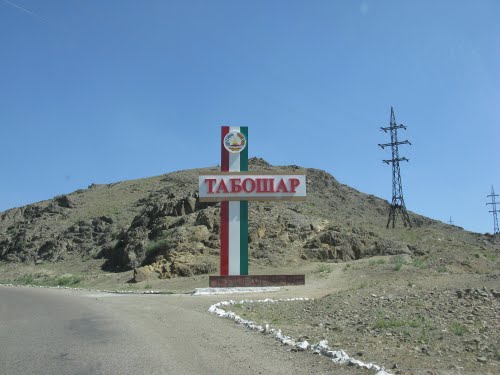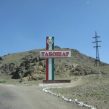
The Legacy of Soviet Nuclear Industry in Tajikistan: Opportunities and Challenges
Publication: Eurasia Daily Monitor Volume: 9 Issue: 81
By:

In April, Rustam Latifov, the head of the Tajik Parliament’s Ecological Commission, announced Tajikistan’s intention to seek international donors to help secure more than 50,000 tons of radioactive waste in Taboshar and distribute humanitarian funds for 2,000 people in the immediate vicinity who are particularly exposed in the villages of Old Taboshar and Somoni (ozodi.org, April 12). Taboshar, situated in the Ferghana Valley of Sugd Oblast just north of Khujand (Tajikistan’s second largest city), is one of ten Soviet-era nuclear sites in the country. While a part of the Soviet Union, Sugd Oblast was a center for both the extraction and enrichment of uranium. Mines in Taboshar and Adrasman provided uranium to the Leninabad Mining and Chemical Combine (now the Vostochnyy Rare Metal Industrial Association, or Vostokredmet) in the city of Chkalovsk. The then-Leninabad plant processed up to 1,000,000 metric tons of uranium a year to enrich yellowcake and uranium hexafluoride and provided the material for the USSR’s first nuclear weapon (https://www.nti.org/country-profiles/tajikistan/).
After the fall of the Soviet Union, uranium enrichment largely stopped, and Tajikistan joined with Russia, the United States and the international community to control its nuclear sites. Tajikistan signed the Non-Proliferation Treaty NPT in 1994, the Comprehensive Nuclear Test Ban Treaty (CTBT) in 1998, became a member of the International Atomic Energy Agency (IAEA) in 2001 and in 2006, along the with other Central Asian states of the CIS, signed a treaty creating a Central Asia Nuclear-Weapon-Free-Zone (CANWFZ) (https://www.nti.org/country-profiles/tajikistan/). Tajikistan is also a participant in the Global Threat Reduction Initiative (GTRI) whose mission is to “reduce and protect vulnerable nuclear and radiological materials located at civilian sites worldwide” (https://nnsa.energy.gov/). Despite showing a commitment to non-proliferation, Tajikistan has traditionally lacked adequate funds to deal with the legacy of its nuclear industry. In Khujand, radiation levels measure up to 80 micro-roentgen/hour, and in Adrasman, the background radiation is over 1,400 micro-roentgen/hour (the officially acceptable level nationwide is 57) (IWPR.org, October 6, 2006). In addition to the populations in Sugd, the proximity of eight radioactive sites to the Syr Daria River threatens the environment of the entire Ferghana Valley and its 10 million residents (https://www.wise-uranium.org).
As well as health and environmental concerns, Tajikistan’s fragile stability and porous borders have raised concerns over security of these nuclear sites. In 2009, five employees of the Vostokredmet plant in Chkalovsk were convicted of committing espionage for Uzbekistan and received prison sentences of up to 22 years (IWPR, December 21, 2009). Among the convicted were the director of the plant, Shavkat Bobojonov, its chief engineer, Aleksandr Botov, and the facility’s internal security chief, Matin Ziyoev (rferl.org, July 23, 2009, rferl.org, May 25, 2009) Additionally, in 2005 authorities thwarted a plot by a citizen of Uzbekistan to smuggle weapons-grade nuclear material for sale in Afghanistan or Pakistan (IWPR, February 21, 2005).
Incidents such as these, combined with problems of narcotics trafficking, have prompted strong international support for strengthening border security in Tajikistan and Central Asia via initiatives such as the OSCE-supported Central Asia Border Security Initiative (CABSI) (www.osce.org, April 16). The EurAsian Economic Community (EurAsEC) has also pledged support for securing these sites and recently announced its decision to allocate $30 million for “soil remediation” at facilities in Kyrgyzstan (Kadzhi-Sai and Min-Kush) and Tajikistan (Taboshar). According to EurAsEC Secretary-General Tair Mansurov, the plan is projected to be implemented over a span of five years by the state-owned Russian company ROSTAM, which will provide 75 percent of the funding (www.inform.kz/eng, April 8; Ria Novosti, August 17, 2010).
The presence of rare minerals at some sites, such as the Kalon Konimansur silver mine in Adrasman, has also attracted private sector interest and provided both government officials and investors an additional incentive to control radioactive sites. In March, Tajik officials agreed to a summer deadline for announcing the winner of a $3 billion bid to develop Tajikistan’s Kalon Konimansur silver mine (Business News Europe, March 15). The decision will give the winner 25-year exclusive rights to the Kalon Konimansur situated in the village of Adrasman in Sugd Oblast. The mine is estimated to have between 50,000-70,000 tons of silver at a ratio of 49 grams of silver per ton as well as 480 grams of lead and 380 grams of zinc per ton. Currently, BHP Billiton and an international consortium consisting of Glencore International, Kazzinc, Konimansur and Tajikistan’s Adrasman ore refinery are the only two companies in the running after Chinese competitors dropped out (ozodi.org January 28, 2011; Paikon, Маrch 12, 2010). The announcement of a winner would end a six-year bidding process and be one of the largest private investment ventures in post-Soviet Tajikistan. In addition to providing up to 15,000 jobs in an economically depressed region, the successful execution of the deal would serve as a model for attracting foreign investment. However the mine’s proximity to defunct uranium mines and nuclear waste dumps, a well as its projected open pit design would require the relocation of 13,000 people living in the village of Adrasman (Business News Europe, March 15).
While the uranium deposits in northern Tajikistan are believed to be exhausted, officials maintain that the mountainous, southeastern Gorno-Badakhshon region is rich in uranium and other minerals. In 2008, President Emomali Rahmon reversed a previous ban on foreign extraction of uranium and welcomed the exploration of potential reserves that his administration has estimated to account for 14 percent of the world supply (www.cacianalyst.com, September 16, 2009). This claim has not been independently confirmed, but the change of policy quickly attracted interest from India and China. Rahmon has reportedly given China’s Guangdong Corp. and Uranium Corporation of India Ltd. permission to explore uranium deposits (https://minerals.usgs.gov, Deccan Herald, September 10, 2009). Iran has long shown an interest in developing Tajikistan’s uranium sector, however according to Todzhiddin Makhmadov, chief of the Emergency Situations Committee’s radiology laboratory, Tajikistan refused Iranian attempts to export radioactive sources from Tajikistan on at least four separate occasions (2004, 2006, 2008 and in 2009) (Ria Novosti, August 17, 2010). This stance was reaffirmed in 2010 when the Secretary of Nuclear and Radioactive Security Agency of Tajikistan, Hekmat Nasrallah, at a roundtable discussion on “International Day Against Nuclear Testing” stated that the country does not cooperate with Iran in the exporting and processing of uranium (radiofarda.org, August 20, 2010). Tajikistan’s nuclear policy vis-a-vis Iran mirrors that of other regional governments such as Kazakhstan although Tajikistan has on many occasions expressed public support of a peaceful Iranian nuclear program (EDM, March 27).
In a country where more than 40 percent of the GDP is comprised of foreign remittances, Tajikistan’s mineral wealth presents it with a good opportunity for economic development (www.worldbank.org). However, successfully exploiting its resources depends on the government creating an attractive atmosphere for investors. If Tajikistan develops its reserves in a sustainable way in the model of other mineral rich countries like Botswana, avoids nepotism and kleptocratic tendencies in the privatization of public resources, and guards against “Dutch disease” by reinvesting its profits in other industries, the development of the mining sector could help alleviate the serious economic ails afflicting the country.




